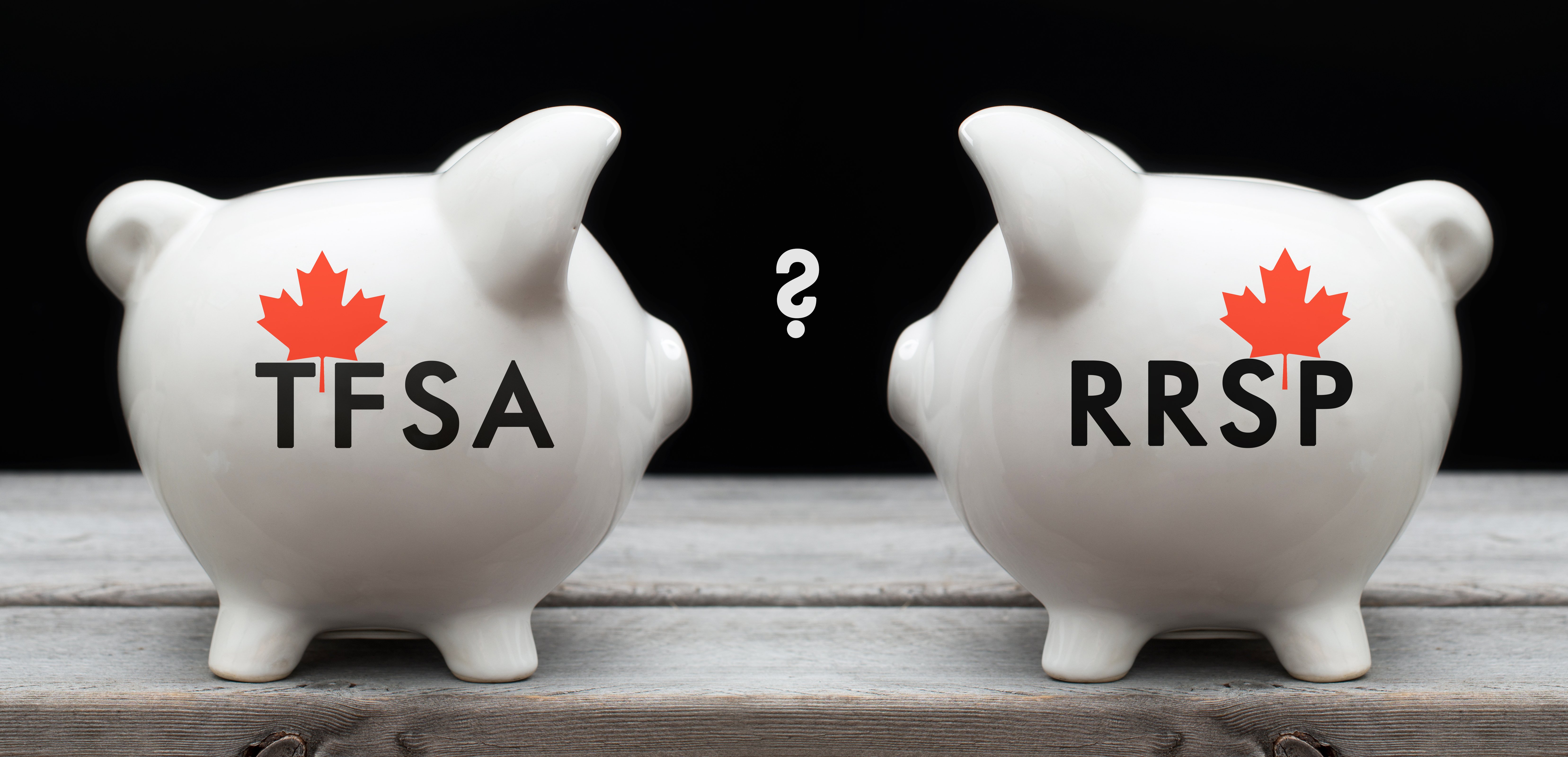
TFSA vs. RRSP: How To Choose Between the Two?
DD Images / Shutterstock
Choosing between the TFSA vs RRSP is easier than you think. Everyone should have both a TFSA and an RRSP, preferably in an investment account. The TFSA makes sense for virtually everyone, but the RRSP is best for high-income earners or when your TFSA is maxed out.
When it comes to saving, the TFSA vs. RRSP debate is always at the forefront. Many people are confused as to whether to choose the Registered Retirement Savings Plan (RRSP), a Tax-Free Savings Account (TFSA), or a combo of both to put money away for the future.
Regardless of whether you choose the RRSP or TFSA (or make use of both!), one of the best things you can do is invest consistently. This is why I recommend setting up a pre-authorized “set it and forget it” investment solution to pay yourself first. Over time, you can gradually increase your contributions until you max out both accounts.
Both RRSP and TFSA investments are vehicles that shelter taxes on your investment returns, but depending on your circumstances, one might be better for your money than the other.
The TFSA is more flexible and offers a better tax benefit than the RRSP but doesn’t have as high contribution room. The RRSP will probably let you set aside more but has stricter rules around when you can withdraw your money and the reason behind it. Ultimately, everyone should aim to have both an RRSP and a TFSA and spread the savings across both accounts.
The TFSA lowdown
The TFSA was introduced in 2009 to give Canadians a more flexible savings tool. Like the RRSP, the TFSA is best used for retirement savings. However, unlike the RRSP, the TFSA can also be used for anything else! Here are the top five points to remember about TFSAs:
- It’s a very flexible, all-purpose savings tool that allows you to contribute and withdraw from a tax-sheltered account easily and without penalty.
- You can open a TFSA as soon as you turn 18, and there’s no expiry.
- You can make tax-free withdrawals from your TFSA anytime, for any purpose. You can only replace the withdrawal amount in the same year if you have available TFSA contribution room (unless you want to pay a penalty). The contribution room is returned the following calendar year.
- When you retire and start pulling money out of your RRSP and TFSA accounts, the government considers your RRSP withdrawals when “clawing back” your Old Age Security (OAS). But this is not the case when withdrawing from TFSA — a big bonus.
- Some employers only offer pension-match contributions for RRSP contributions. If this is the case, go with an RRSP vs. TFSA!
READ MORE: A guide to TFSAs
The basic lowdown on the RRSP
The RRSP was introduced in 1957 to help Canadians save for retirement. Here are the top eight points to remember about RRSPs:
- Since contributions are done with pre-tax income, you can claim a tax deduction in the year you contribute. If you don’t re-invest your tax refund, then you lose out on the pre-tax advantages.
- Unlike a TFSA, you will have to pay tax when you make a withdrawal. RRSP must be converted to a Registered Retirement Income Fund (RRIF) by December 31 of the year you turn 71.
- The maximum RRSP contribution is 18% of your gross income or $29,210, whichever is lower. Any unused contribution room can be carried forward to the following year.
- Two exceptions allow you to withdraw from your RRSP for purposes other than retirement. However, you will need to repay the amount:
- Home Buyers Plan (withdraw up to $35,000 for a down payment on your first home, and repay over 15 years)
- Lifelong Learning Plan ($10,000 per year to a maximum of $20,000 for school, and repay over 10 years)
- RRSPs are a great place to park US-based equities.
- RRSPs are especially beneficial for Canadians in a high tax bracket. If you aren’t making much money in a given year (e.g., if you are a student), there isn’t too much point in chasing a big tax refund via an RRSP contribution. You already aren’t taxed very much (if at all), so you won’t get much of your taxes paid back. Go for a TFSA!
READ MORE: A guide to RRSPs
Main difference between RRSP and TFSA
The main difference between the RRSP and TFSA is how your income is taxed when you contribute or withdraw from each account. The RRSP is a tax-deferred account, which means you contribute to it with pre-tax dollars and you’ll pay your income taxes on your withdrawals. In contrast, the TFSA is a tax-free account – meaning you contribute to it with after-tax income, so you’ll pay no more income taxes when you make a withdrawal. Because of this tax structure, you should come out with the same amount of money whether you choose the RRSP or TFSA, which is why you shouldn’t sweat your TFSA vs. RRSP decision too much.
For example, here’s what happens when you compare putting your earned income in a TFSA vs. RRSP:
Keep in mind the above table makes a few assumptions, namely that if you claim your RRSP contribution at tax time to get a refund, you deposit that refund into your RRSP. If you make RRSP contributions and claim them when you file your tax income but don’t use the tax benefit to further top up your investment, the calculations won’t be the same. Likewise, the calculations assume you know what your marginal tax rate will be during retirement, which is difficult to predict if you’re in your 20s or 30s!
TFSA vs. RRSP comparison
Despite their names, neither the RRSP nor TFSA has to be a savings account. You can and should hold various investments in your accounts, such as GICs, mutual funds, stocks, bonds, and ETFs. Both of these accounts should be more appropriately named “Tax-Free Investment Account” and “Registered Retirement Investment Plan” because investing is really the best way to unlock the power of these accounts.
The real difference between the RRSP and TFSA comes down to their contribution limits and withdrawal restrictions, as well as how and when you pay taxes at these events. Our chart below summarizes some of the pros and cons of TFSAs and RRSPs.
Comparing TFSA vs. RRSP
Comparison of the best TFSA and RRSP accounts
Investing in your TFSA or RRSP is always a good idea. But if you need quick access to cash, a smart strategy is to keep some savings stashed in a TFSA or RRSP high-interest savings account to complement your investments.
But I can’t emphasize this enough: To really supercharge your RRSP or TFSA, make sure to open an investment account. Do not be fooled by the word “saving” in either name – these are investment accounts!
The TFSA or RRSP is best used for investing rather than saving. If you use the TFSA or RRSP to invest in long-term equities, you can shelter a substantial amount of investment earnings. Would you rather shelter the 2% you are getting in a high-interest savings account or the 7%-8% a balanced index ETF portfolio could snag you?
The bottom line: you should have both a TFSA and an RRSP, preferably in an investment account. The TFSA makes sense for virtually everyone, but the RRSP becomes increasingly relevant if you’re at a high income or your TFSA is maxed out.
How to invest your TFSA or RRSP
Thanks to the internet, it’s really easy to invest your TFSA or RRSP. To open a TFSA or RRSP investing account, you have several options:
Robo-advisors
If you’re looking for growth, low fees, and some investing guidance, a robo-advisor is a great option for investing your TFSA or RRSP that follows the couch potato investment strategy. Here’s how it works: when signing up for a robo-advisor, you answer a series of questions, and then the computer algorithm suggests a portfolio that matches your financial goals and risk tolerance. Then, just set up pre-authorized contributions and let the robo-advisor do the work of monitoring and rebalancing your portfolio – at a much lower fee than what traditional financial advisors and mutual funds charge.
READ MORE: Complete guide to the best robo-advisors in Canada
Online brokerage
If you’re comfortable with DIY investing, you can create your own retirement investment plan or replicate some of the robo-advisors’ portfolios. All you have to do is set up a TFSA or RRSP investing account with an online brokerage and then make the trades on your own. Yes, it’s true that you must pay for some of your transactions, but overall, the management expense ratio would likely be lower than robo-advisors. Plus, some online brokerages offer zero-commission trading.
READ MORE: The best online brokerages in Canada
TFSA or RRSP savings account
Lastly, if you’re looking to stash some cash for the short term, consider opening a TFSA or RRSP savings account with a bank that offers a high-interest rate.
Final thoughts
RRSP vs. TFSA? Ideally, you should spread out your savings and contribute to both. Whether you choose the RRSP or TFSA (or both), you’ll likely come out with the same amount of money because of the tax structure. The important thing is to start saving now and make regular contributions to a TFSA or RRSP. That way, you know you have all your bases covered when it’s time to retire.
Read more: What are RRSPs, TFSAs, and RESPs anyway?
Disclaimer
The content provided on Money.ca is information to help users become financially literate. It is neither tax nor legal advice, is not intended to be relied upon as a forecast, research or investment advice, and is not a recommendation, offer or solicitation to buy or sell any securities or to adopt any investment strategy. Tax, investment and all other decisions should be made, as appropriate, only with guidance from a qualified professional. We make no representation or warranty of any kind, either express or implied, with respect to the data provided, the timeliness thereof, the results to be obtained by the use thereof or any other matter.





